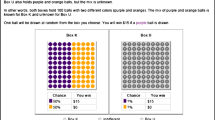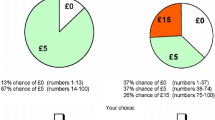Abstract
This study provides an empirical perspective on the effect of ambiguous environmental risk information on lottery preferences using a sample of 646 adults. The learning process follows a Bayesian expected utility model in terms of the overall magnitude and sign of the weights that respondents place on the risk information. Significant ambiguous belief aversion that is consistent with the Ellsberg paradox is also evident. The extent of this aversion increases with the size of the risk spread, but at a decreasing rate. These results are consistent with both probability-based and preference-based models of ambiguous probabilities. The findings also indicate the presence of cognitive limitations in the processing of risk information, but lead to rejection of more extreme models in which individuals respond in alarmist fashion or do not learn at all.
Similar content being viewed by others
References
Camerer, Colin and Howard Kunreuther. (1989a). “Decision Processes for Low Probability Risks: Policy Implications,” Journal of Policy Analysis and Management 8(4), 565–592.
Camerer, Colin and Howard Kunreuther. (1989b). “Experimental Markets for Insurance,” Journal of Risk and Uncertainty 2(3), 265–300.
Einhorn, Hillel J. and Robin M. Hogarth. (1985). “Ambiguity and Uncertainty in Probabilistic Inference,” Psychological Review 92(4), 433–461.
Einhorn, Hillel J. and Robin M. Hogarth. (1986). “Decision Making Under Ambiguity,” Journal of Business 59(4), part 2, S225-S250.
Ellsberg, Daniel. (1961). “Risk, Ambiguity, and the Savage Axioms,” Quarterly Journal of Economics 75, 643–669.
Heath, Chip and Amos Tversky. (1991). “Preference and Belief: Ambiguity and Competence in Choice Under Uncertainty,” Journal of Risk and Uncertainty 4(1), 5–28.
Heath, Chip and Amos Tversky. (1991). “Preference and Belief: Ambiguity and Competence in Choice Under Uncertainty,” Journal of Risk and Uncertainty 4(1), 5–28.
Hogarth, Robin and Howard Kunreuther. (1985). “Ambiguity and Insurance Decisions,” American Economic Review 75(2), 386–390.
Kahneman, Daniel and Amos Tversky. (1979). “Prospect Theory: An Analysis of Decision Under Risk,” Econometrica 47, 263–291.
Kunreuther, Howard and Robin M. Hogarth. (1989). “Risk, Ambiguity and Insurance,” Journal of Risk and Uncertainty 2, 5–35.
Kunreuther, Howard and Robin M. Hogarth. (1990). “How Does Ambiguity Affect Insurance Decisions?” working paper, Wharton School of Business, University of Pennsylvania.
Machina, Mark J. (1987). “Choice Under Uncertainty: Problems Solved and Unsolved,” Journal of Economic Perspectives 1(1), 121–154.
Raiffa, Howard. (1961). “Risk, Ambiguity, and the Savage Axioms: Comment,” Quarterly Journal of Economics 75, 690–694.
Smith, Vernon L. (1969). “Measuring Nonmonetary Utilities in Uncertain Choices: The Ellsberg Urn,” Quarterly Journal of Economics 83, 324–329.
Smith, V. Kerry and F. Reed Johnson. (1988). “How Do Risk Perceptions Respond to Information? The Case of Radon,” Review of Economics and Statistics 70(1), 1–8.
Tversky, Amos and Daniel Kahneman. (1986). “Rational Choice and the Framing of Decision,” Journal of Business 59(4), part 2, S251-S278.
Viscusi, W. Kip. (1979). Employment Hazards: An Investigation of Market Performance. Cambridge: Harvard University Press.
Viscusi, W. Kip. (1989). “Prospective Reference Theory: Toward an Explanation of the Paradoxes,” Journal of Risk and Uncertainty 2(4), 235–264.
Viscusi, W. Kip. (1990). “Sources of Inconsistency in Societal Responses to Health Risks,” American Economic Review 80(2), 257–261.
Viscusi, W. Kip and Charles O'Connor. (1984). “Adaptive Responses to Chemical Labeling: Are Workers Bayesian Decision Makers?,” American Economic Review 74, 942–956.
Viscusi, W. Kip, Wesley Magat, and Joel Huber. (1991). “Communication of Ambiguous Risk Information,” Theory and Decision 31 (2/3), 159–173.
White, Halbert L. (1980). “A Heteroskedasticity-Consistent Covariance Matrix Estimator and a Direct Test for Heteroskedasticity,” Econometrica 48, 817–838.
Winkler, Robert (1991). “Ambiguity, Probability, Preference, and Decision Analysis,” Journal of Risk and Uncertainty 4(3), 285–297.
Zeckhauser, Richard. (1986). “Behavioral Versus Rational Economics: What You See Is What You Conquer,” Journal of Business 59(4), part 2, 5435–5450.
Author information
Authors and Affiliations
Additional information
This research was supported by U.S. Environmental Protection Agency Cooperative Agreements #CR-815445-01-2 and #CR-814388-02-1. Helpful comments were provided by Joel Huber, John Payne, Alan Carlin, William Evans, Ann Fisher, Dr. Doyle Graham, Dr. Douglas Anthony, and seminar participants at several universities. Patricia Born provided excellent computer assistance, and Jon LaScala assisted in the administration of the survey.
Rights and permissions
About this article
Cite this article
Viscusi, W.K., Magat, W.A. Bayesian decisions with ambiguous belief aversion. J Risk Uncertainty 5, 371–387 (1992). https://doi.org/10.1007/BF00122576
Issue Date:
DOI: https://doi.org/10.1007/BF00122576




